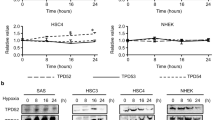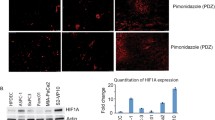Abstract
Purpose
Hypoxic tumor cells overexpressing hypoxia-inducible factor 1alpha (HIF-1α) are generally resistant to chemo/radiotherapy. We have reported that Se-methylselenocysteine (MSC) therapeutically enhances the efficacy and selectivity of irinotecan against human tumor xenografts. The aim of this study was to delineate the mechanism responsible for the observed efficacy targeting on HIF-1α and its transcriptionally regulated genes VEGF and CAIX.
Methods
We investigated the mechanism of HIF-1α inhibition by MSC and its critical role in the therapeutic outcome by generating HIF-1α stable knockdown (KD) human head and neck squamous cell carcinoma, FaDu by transfecting HIF-1α short hairpin RNA.
Results
While cytotoxic efficacy in combination with methylselenic acid (MSA) with SN-38 (active metabolites of MSC and irinotecan) could not be confirmed in vitro against normoxic tumor cells, the hypoxic tumor cells were more sensitive to the combination. Reduction in HIF-1α either by MSA or shRNA knockdown resulted in significant increase in cytotoxicity of SN38 in vitro against hypoxic, but not the normoxic tumor cells. Similarly, in vivo, either MSC in combination with irinotecan treatment of parental xenografts or HIF-1α KD tumors treated with irinotecan alone resulted in comparable therapeutic response and increase in the long-term survival of mice bearing FaDu xenografts.
Conclusions
Our results show that HIF-1α is a critical target for MSC and its inhibition was associated with enhanced antitumor activity of irinotecan. Inhibition of HIF-1α appeared to be mediated through stabilization of PHD2, 3 and downregulation of ROS by MSC. Thus, our findings support the development of MSC as a HIF-1α inhibitor in combination chemotherapy.






Similar content being viewed by others
References
Cao S, Durrani FA, Rustum YM (2004) Selective modulation of the therapeutic efficacy of anticancer drugs by selenium containing compounds against human tumor xenografts. Clin Cancer Res 10:2561–2569
Bhattacharya A, Seshadri M, Oven SD et al (2008) Tumor vascular maturation and improved drug delivery induced by methylselenocysteine leads to therapeutic synergy with anticancer drugs. Clin Cancer Res 14:3926–3932
Yin MB, Li ZR, Toth K et al (2006) Potentiation of irinotecan sensitivity by Se-methylselenocysteine in an in vivo tumor model is associated with downregulation of cyclooxygenase-2, inducible nitric oxide synthase, and hypoxia-inducible factor 1alpha expression, resulting in reduced angiogenesis. Oncogene 25:2509–2519
Fleet JC (1997) Dietary selenium repletion may reduce cancer incidence in people at high risk who live in areas with low soil selenium. Nutr Rev 55:277–279
Clark LC, Combs GF Jr, Turnbull BW et al (1996) Effects of selenium supplementation for cancer prevention in patients with carcinoma of the skin. A randomized controlled trial. Nutritional Prevention of Cancer Study Group. JAMA 276:1957–1963
Lippman SM, Klein EA, Goodman PJ et al (2009) Effect of selenium and vitamin E on risk of prostate cancer and other cancers: the Selenium and Vitamin E Cancer Prevention Trial (SELECT). JAMA 301:39–51
Miki K, Xu M, Gupta A et al (2001) Methioninase cancer gene therapy with selenomethionine as suicide prodrug substrate. Cancer Res 61:6805–6810
Sinha R, Said TK, Medina D (1996) Organic and inorganic selenium compounds inhibit mouse mammary cell growth in vitro by different cellular pathways. Cancer Lett 107:277–284
Patiar S, Harris AL (2006) Role of hypoxia-inducible factor-1alpha as a cancer therapy target. Endocr Relat Cancer 13(Suppl 1):S61–S75
Semenza GL (2003) Targeting HIF-1 for cancer therapy. Nat Rev Cancer 3:721–732
Liu L, Ning X, Sun L et al (2008) Hypoxia-inducible factor-1 alpha contributes to hypoxia-induced chemoresistance in gastric cancer. Cancer Sci 99:121–128
Unruh A, Ressel A, Mohamed HG et al (2003) The hypoxia-inducible factor-1 alpha is a negative factor for tumor therapy. Oncogene 22:3213–3220
Chandel NS, McClintock DS, Feliciano CE et al (2000) Reactive oxygen species generated at mitochondrial complex III stabilize hypoxia-inducible factor-1alpha during hypoxia: a mechanism of O2 sensing. J Biol Chem 275:25130–25138
Callapina M, Zhou J, Schmid T et al (2005) NO restores HIF-1alpha hydroxylation during hypoxia: role of reactive oxygen species. Free Radic Biol Med 39:925–936
Berra E, Benizri E, Ginouves A et al (2003) HIF prolyl-hydroxylase 2 is the key oxygen sensor setting low steady-state levels of HIF-1alpha in normoxia. EMBO J 22:4082–4090
Brahimi-Horn MC, Chiche J, Pouyssegur J (2007) Hypoxia signalling controls metabolic demand. Curr Opin Cell Biol 19:223–229
Gillespie DL, Whang K, Ragel BT et al (2007) Silencing of hypoxia inducible factor-1alpha by RNA interference attenuates human glioma cell growth in vivo. Clin Cancer Res 13:2441–2448
Azrak RG, Frank CL, Ling X et al (2006) The mechanism of methylselenocysteine and docetaxel synergistic activity in prostate cancer cells. Mol Cancer Ther 5:2540–2548
Chintala S, Li W, Lamoreux ML et al (2005) Slc7a11 gene controls production of pheomelanin pigment and proliferation of cultured cells. Proc Natl Acad Sci U S A 102:10964–10969
Pastorekova S, Ratcliffe PJ, Pastorek J (2008) Molecular mechanisms of carbonic anhydrase IX-mediated pH regulation under hypoxia. BJU Int 101(Suppl 4):8–15
Bhattacharya A, Toth K, Mazurchuk R et al (2004) Lack of microvessels in well-differentiated regions of human head and neck squamous cell carcinoma A253 associated with functional magnetic resonance imaging detectable hypoxia, limited drug delivery, and resistance to irinotecan therapy. Clin Cancer Res 10:8005–8017
Adamski JK, Estlin EJ, Makin GW (2008) The cellular adaptations to hypoxia as novel therapeutic targets in childhood cancer. Cancer Treat Rev 34:231–246
Haugland HK, Vukovic V, Pintilie M et al (2002) Expression of hypoxia-inducible factor-1alpha in cervical carcinomas: correlation with tumor oxygenation. Int J Radiat Oncol Biol Phys 53:854–861
Loncaster JA, Harris AL, Davidson SE et al (2001) Carbonic anhydrase (CA IX) expression, a potential new intrinsic marker of hypoxia: correlations with tumor oxygen measurements and prognosis in locally advanced carcinoma of the cervix. Cancer Res 61:6394–6399
Cvetkovic D, Movsas B, Dicker AP et al (2001) Increased hypoxia correlates with increased expression of the angiogenesis marker vascular endothelial growth factor in human prostate cancer. Urology 57:821–825
Airley R, Loncaster J, Davidson S et al (2001) Glucose transporter glut-1 expression correlates with tumor hypoxia and predicts metastasis-free survival in advanced carcinoma of the cervix. Clin Cancer Res 7:928–934
Vaupel P, Mayer A (2007) Hypoxia in cancer: significance and impact on clinical outcome. Cancer Metastasis Rev 26:225–239
Teicher BA (1994) Hypoxia and drug resistance. Cancer Metastasis Rev 13:139–168
Brown LM, Cowen RL, Debray C et al (2006) Reversing hypoxic cell chemoresistance in vitro using genetic and small molecule approaches targeting hypoxia inducible factor-1. Mol Pharmacol 69:411–418
Semenza GL (2007) Evaluation of HIF-1 inhibitors as anticancer agents. Drug Discov Today 12:853–859
Gao P, Zhang H, Dinavahi R et al (2007) HIF-dependent antitumorigenic effect of antioxidants in vivo. Cancer Cell 12:230–238
Zhang H, Qian DZ, Tan YS et al (2008) Digoxin and other cardiac glycosides inhibit HIF-1alpha synthesis and block tumor growth. Proc Natl Acad Sci U S A 105:19579–19586
Lee K, Qian DZ, Rey S et al (2009) Anthracycline chemotherapy inhibits HIF-1 transcriptional activity and tumor-induced mobilization of circulating angiogenic cells. Proc Natl Acad Sci USA 106:2353–2358
Tang N, Wang L, Esko J et al (2004) Loss of HIF-1alpha in endothelial cells disrupts a hypoxia-driven VEGF autocrine loop necessary for tumorigenesis. Cancer Cell 6:485–495
Erler JT, Cawthorne CJ, Williams KJ et al (2004) Hypoxia-mediated down-regulation of Bid and Bax in tumors occurs via hypoxia-inducible factor 1-dependent and -independent mechanisms and contributes to drug resistance. Mol Cell Biol 24:2875–2889
Mizuno T, Nagao M, Yamada Y et al (2006) Small interfering RNA expression vector targeting hypoxia-inducible factor 1 alpha inhibits tumor growth in hepatobiliary and pancreatic cancers. Cancer Gene Ther 13:131–140
Zhang Q, Zhang ZF, Rao JY et al (2004) Treatment with siRNA and antisense oligonucleotides targeted to HIF-1alpha induced apoptosis in human tongue squamous cell carcinomas. Int J Cancer 111:849–857
Stoeltzing O, McCarty MF, Wey JS et al (2004) Role of hypoxia-inducible factor 1alpha in gastric cancer cell growth, angiogenesis, and vessel maturation. J Natl Cancer Inst 96:946–956
Pencreach E, Guerin E, Nicolet C et al (2009) Marked activity of irinotecan and rapamycin combination toward colon cancer cells in vivo and in vitro is mediated through cooperative modulation of the mammalian target of rapamycin/hypoxia-inducible factor-1{alpha} axis. Clin Cancer Res 15:1297–1307
Fakih MG, Pendyala L, Brady W et al (2008) A Phase I and pharmacokinetic study of selenomethionine in combination with a fixed dose of irinotecan in solid tumors. Cancer Chemother Pharmacol 62:499–508
Platz EA (2009) Selenium, genetic variation, and prostate cancer risk: epidemiology reflects back on selenium and vitamin E cancer prevention trial. J Clin Oncol 27:3569–3572
Chan JM, Oh WK, Xie W et al (2009) Plasma selenium, manganese superoxide dismutase, and intermediate- or high-risk prostate cancer. J Clin Oncol 27:3577–3583
Stiehl DP, Wirthner R, Koditz J et al (2006) Increased prolyl 4-hydroxylase domain proteins compensate for decreased oxygen levels. Evidence for an autoregulatory oxygen-sensing system. J Biol Chem 281:23482–23491
Nakayama K, Frew IJ, Hagensen M et al (2004) Siah2 regulates stability of prolyl-hydroxylases, controls HIF1alpha abundance, and modulates physiological responses to hypoxia. Cell 117:941–952
Moller A, House CM, Wong CS et al (2009) Inhibition of Siah ubiquitin ligase function. Oncogene 28:289–296
Zhong H, Semenza GL, Simons JW, De Marzo AM (2004) Up-regulation of hypoxia-inducible factor 1alpha is an early event in prostate carcinogenesis. Cancer Detect Prev 28:88–93
Kimbro KS, Simons JW (2006) Hypoxia-inducible factor-1 in human breast and prostate cancer. Endocr Relat Cancer 13:739–749
Zhong H, Chiles K, Feldser D et al (2000) Modulation of hypoxia-inducible factor 1alpha expression by the epidermal growth factor/phosphatidylinositol 3-kinase/PTEN/AKT/FRAP pathway in human prostate cancer cells: implications for tumor angiogenesis and therapeutics. Cancer Res 60:1541–1545
Acknowledgments
This study was supported by a grant from National Cancer Institute 1R21CA133682-01A2 (S. Chintala) and a Comprehensive Cancer Center Support grant CA 016056 from National Cancer Institute, Bethesda, Maryland, USA. We thank Dr. Harry Slocum for the review of this manuscript, Dr. Jaromir Pastorek for providing antibody M75 for CAIX studies, and Rebecca Dean for technical support.
Conflict of interest statement
None.
Author information
Authors and Affiliations
Corresponding author
Rights and permissions
About this article
Cite this article
Chintala, S., Tόth, K., Cao, S. et al. Se-methylselenocysteine sensitizes hypoxic tumor cells to irinotecan by targeting hypoxia-inducible factor 1α. Cancer Chemother Pharmacol 66, 899–911 (2010). https://doi.org/10.1007/s00280-009-1238-8
Received:
Accepted:
Published:
Issue Date:
DOI: https://doi.org/10.1007/s00280-009-1238-8




